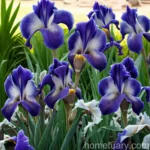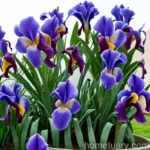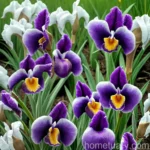The Allure of Iris Maackii: A Comprehensive Guide to Cultivation and Care
Iris maackii is an exquisite flowering plant that belongs to the iris family, known for its stunning blooms and elegant foliage. This article will provide an in-depth exploration of the cultivation, characteristics, landscape uses, ecological significance, and much more about iris maackii. Whether you are a seasoned horticulturist, a passionate gardener, or an avid plant enthusiast, this guide aims to equip you with the knowledge necessary to cultivate and care for iris maackii in various settings, from gardens to indoor containers.
What is Iris Maackii?
Iris maackii, commonly known as Maack’s iris, is a perennial flowering plant native to Eastern Asia, particularly China, Korea, and Russia. It is a member of the Iridaceae family and is renowned for its graceful, iris-like flowers and slender, sword-shaped leaves.
The species was named after Richard Karlovich Maack (1825–1886), a Russian naturalist and traveler who extensively studied the flora and fauna of Siberia. Iris maackii typically thrives in moist woodland areas, meadows, and along the edges of forests. This striking plant is valued not only for its ornamental beauty but also for its ecological significance in providing habitat and sustenance for various wildlife species.
Iris maackii can reach a height of about 24-36 inches and produces lovely lavender to violet-blue flowers with yellow and white markings. Its blooms are adorned with intricate patterns and exhibit an enchanting fragrance. The foliage is characterized by linear, grass-like leaves that form dense clumps and contribute to the plant’s overall aesthetic appeal.
Key Takeaways – Iris Maackii
Before delving into the specifics of iris maackii’s cultivation and care, let’s highlight some key takeaways regarding this captivating plant:
-
Iris Maackii Cultivation: Iris maackii is a perennial plant that thrives in moist woodland areas and is native to Eastern Asia, particularly China, Korea, and Russia.
-
Plant Characteristics: This species is known for its elegant lavender to violet-blue blooms with yellow and white markings. It features slender, sword-shaped leaves and a delightful fragrance.
-
Landscape Uses: Iris maackii is an ideal choice for garden borders, containers, and landscape focal points. It also holds ornamental value and is a wildlife sanctuary, attracting various beneficial insects and pollinators.
-
Ecological Significance: In its native habitat, iris maackii contributes to biodiversity and provides a vital habitat for wildlife, making it a valuable addition to any ecosystem-conscious garden.
-
Medicinal Properties: Historically, certain species of iris have been used for medicinal purposes, although it’s essential to exercise caution and seek professional guidance before using any plant for medicinal applications.
Now that we have a general understanding of iris maackii’s unique qualities, let’s explore the details of how to cultivate, care for, and appreciate this remarkable plant in various settings.
Cultivation and Care of Iris Maackii
Cultivating iris maackii successfully requires a thorough understanding of its specific cultural requirements, including its needs for water, sunlight, soil, and fertilization. Additionally, knowledge of pruning, propagation, and disease and pest management is crucial for the plant’s overall health and vitality. Let’s delve into each aspect of iris maackii’s cultivation and care in detail.
Water
Proper watering is essential for the health and vigor of iris maackii. While this plant thrives in moist conditions, it’s crucial to strike the right balance to prevent waterlogging, which can lead to root rot. Effective watering practices include:
-
Moist, Well-Draining Soil: Iris maackii prefers consistently moist, well-draining soil. Ensure that the soil is evenly moist but not waterlogged. Be attentive to the plant’s water needs, particularly during hot and dry periods.
-
Watering Frequency: In general, iris maackii should be watered regularly, especially during the growing season. However, it’s important to allow the soil to dry slightly between waterings to prevent waterlogged conditions.
-
Watering Technique: Apply water directly to the soil at the base of the plant to ensure that moisture reaches the root zone. Avoid wetting the foliage excessively to mitigate the risk of fungal diseases.
Sunlight
Adequate sunlight is crucial for the healthy growth and blooming of iris maackii. The following guidelines will help ensure optimal sunlight conditions for this plant:
-
Full to Partial Sun: Iris maackii thrives in full to partial sun conditions. Select a planting location that receives at least 6-8 hours of direct sunlight daily for abundant blooms and healthy foliage.
-
Shade Considerations: While iris maackii appreciates sunlight, it can also tolerate light shade, especially in regions with intense heat. However, prolonged periods of shade may result in reduced flowering and overall vigor.
-
Sun Exposure Management: Regularly monitor the plant’s sun exposure, particularly during the peak of summer when intense sunlight and high temperatures can potentially cause stress. Consider providing some afternoon shade in such conditions.
Fertilizer
Applying appropriate fertilizers can significantly enhance the growth and flowering potential of iris maackii. Here are some essential fertilizer-related considerations for this plant:
-
Balanced Fertilization: Use a balanced, slow-release fertilizer formulated for flowering perennials to provide iris maackii with the essential nutrients it needs for robust growth and prolific blooms.
-
Fertilization Schedule: Apply fertilizer in early spring as new growth emerges, following the manufacturer’s guidelines for application rates. Avoid over-fertilization, as this can lead to excessive foliage at the expense of blooms.
-
Nutrient Considerations: Look for fertilizers with a balanced N-P-K (nitrogen, phosphorus, potassium) ratio, such as 10-10-10, to support overall plant health, strong root development, and abundant flowering.
Soil
Iris maackii thrives in well-draining, nutrient-rich soil. Implement the following soil-related considerations to provide an optimal growing medium for this plant:
-
Well-Draining Soil: Ensure that the planting site or container has well-draining soil to prevent water accumulation around the roots. Amending heavy or clay soils with organic matter can improve drainage and enhance the soil structure.
-
Soil pH: Iris maackii prefers a slightly acidic to neutral soil pH range of 6.0-7.0. Conduct a soil test to determine the pH of the planting area and make adjustments if necessary using amendments tailored to the plant’s pH preferences.
-
Mulching: Apply a layer of organic mulch, such as shredded bark or compost, around the base of iris maackii to conserve soil moisture, regulate soil temperature, and suppress weed growth.
Pruning
Pruning plays a fundamental role in maintaining the health, aesthetics, and vigor of iris maackii. Here are essential pruning considerations for this plant:
-
Deadheading Spent Blooms: Regularly remove faded or spent blooms to promote ongoing flowering and prevent the plant from expending energy on seed production.
-
Foliage Maintenance: Trim away any damaged, yellowing, or diseased foliage to maintain the plant’s overall vitality and visual appeal. Use sanitized pruning tools to prevent the spread of potential diseases.
-
Division: Every few years, consider dividing mature iris maackii clumps to rejuvenate the plants, alleviate overcrowding, and promote better airflow and light penetration within the clumps.
Propagation
Propagating iris maackii can be an enriching and rewarding experience. Here are some propagation methods to consider:
-
Division: Divide mature iris maackii clumps in early spring or late summer to create new plants. Carefully separate the rhizomes, ensuring that each division has healthy roots and attached foliage.
-
Seed Propagation: While less common, iris maackii can be propagated from seeds. Collect mature seeds in the fall, and sow them in a prepared seed-starting mix. Provide the seeds with consistent moisture and warmth for germination.
-
Root Cuttings: Root cuttings can also be used to propagate iris maackii. Select healthy, disease-free roots, and plant them in a suitable propagation medium, ensuring adequate moisture and warmth for root development.
With a solid grasp of iris maackii’s water, sunlight, fertilization, soil, pruning, and propagation requirements, let’s turn our attention to disease and pest management to ensure the plant’s long-term health and vitality.
Disease Diagnosis
Iris maackii, like many plants, can be susceptible to certain diseases that, if left unaddressed, can compromise its overall well-being. Understanding the common diseases and their symptoms is essential for timely intervention. Here are some key diseases to be aware of:
-
Leaf Spot: Characterized by the presence of dark, irregular spots on the foliage, leaf spot can be caused by various fungal pathogens. Improving air circulation and avoiding overhead watering can help mitigate leaf spot.
-
Soft Rot: Soft rot, caused by bacterial pathogens, can lead to the rapid decay of the plant’s rhizomes and roots. Preventing overwatering and providing well-draining soil are essential for minimizing the risk of soft rot.
-
Root Rot: Excessive soil moisture, particularly in poorly draining soil, can lead to root rot, where the plant’s roots become waterlogged and subsequently rot. Adjusting the watering regimen and improving soil drainage can alleviate the risk of root rot.
Common Pests
In addition to diseases, iris maackii may encounter pest pressures that can impact its growth and flowering. Recognizing these pests and implementing effective control measures is crucial for maintaining the plant’s health. Common pests include:
-
Aphids: These small, soft-bodied insects can congregate on the underside of leaves and excrete honeydew, leading to the development of sooty mold. Regularly inspect the plant for aphid infestations and use insecticidal soaps or horticultural oils for control.
-
Thrips: Thrips are tiny, slender insects that feed on the plant’s flowers, leaves, and buds. Their feeding can cause distortion and discoloration. Monitor for thrips and consider using insecticidal treatments if populations become problematic.
-
Iris Borers: Iris borers are moth larvae that can cause significant damage to iris plants by tunneling into the rhizomes. Keep the garden area free of debris and practice good sanitation to minimize the presence of iris borer eggs and larvae.
Botanist’s Tips
Integrating the diverse aspects of iris maackii’s cultivation and care can be further enhanced with the following tips from botanical experts:
-
Companion Planting: Pair iris maackii with compatible companion plants such as echinacea, salvia, and asters to create visually appealing and ecologically beneficial garden displays.
-
Winter Protection: In regions with harsh winters, provide winter protection for iris maackii by applying a layer of mulch over the planting area and, if necessary, covering the plants with a breathable fabric to shield them from extreme cold and winter winds.
-
Conserving Water: Implement water conservation techniques, such as utilizing rain barrels and employing mulch to reduce evaporation and maintain soil moisture levels, particularly during dry spells.
-
Container Gardening: Embrace the versatility of iris maackii by cultivating it in containers, allowing for greater flexibility in placement and design possibilities, especially in smaller garden spaces.
These expert insights can contribute to a harmonious and thriving cultivation of iris maackii, while enriching the overall gardening experience.
Fun Facts
To further appreciate the allure of iris maackii, here are some captivating and intriguing fun facts about this remarkable plant:
-
Symbolism: In the language of flowers, irises are associated with meanings such as hope, courage, and admiration, making them symbolic gifts for various occasions.
-
Historical Uses: Different species of iris have historical uses, including being employed for their aromatic qualities in perfumery and as a source of natural dyes for textiles.
-
Wildlife Attraction: Iris maackii’s blooms attract beneficial insects, such as bees and butterflies, contributing to the overall biodiversity and ecological balance of the garden environment.
-
Fragrance: The blooms of iris maackii exude a delightful fragrance, adding a sensory dimension to the plant’s visual appeal.
These fun facts underscore the rich tapestry of history, symbolism, and ecological interactions associated with iris maackii.
Links to External Resources
For those seeking further information and resources on iris maackii, the following links provide valuable insights into its cultivation, care, and ecological significance:
- American Iris Society: American Iris Society
- Royal Horticultural Society: Royal Horticultural Society
- University of Illinois Extension – Perennials: University of Illinois Extension
- Missouri Botanical Garden – Plant Finder: Missouri Botanical Garden
- The Iris Database – Iris Wiki: The Iris Database
These resources offer a wealth of information, including detailed cultivation guides, identification tips, and historical insights into iris maackii.
In conclusion, iris maackii stands as a captivating and multi-faceted plant, offering a symphony of beauty, ecological significance, and cultural resonance. By carefully attending to its specific cultivation and care needs, we can embrace the enchanting presence of this species in our gardens, landscapes, and indoor spaces. Whether it’s the elegance of its blooms, the subtlety of its fragrance, or its role in fostering biodiversity, iris maackii remains an enduring emblem of natural grace and horticultural allure.
With the knowledge and insights shared in this comprehensive guide, may your journey with iris maackii be filled with blooms, vitality, and a deeper appreciation of the botanical wonders that adorn our world.















